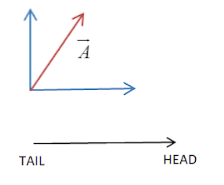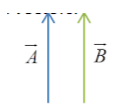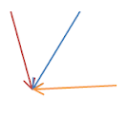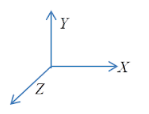
Explain vectors with the help of examples.
Answer
408.6k+ views
Hint: Some quantities have two characteristics, a magnitude and a direction while some have only magnitude and no direction. Such quantities help us deal with multi-dimensional problems. They are represented by an arrow.
Complete answer:
A quantity which has both magnitude and direction is called a vector.A vector is defined by its magnitude that is length and its orientation that is the direction. Examples of vector quantities are velocity,displacement etc.A vector is represented by use of an arrow in a specific direction drawn to scale. Representation:$\overrightarrow{A}$

-The vector arrow has a head and a tail.
-Magnitude of a vector is shown as the length of the line segment.
-Direction is shown by the orientation of the line segment and by an arrow at one end.
Types of vectors: There are many different types of vectors:
Equal vectors: Two vectors in the same direction having equal magnitudes are called equal vectors. Example:

Zero vector: A vector whose magnitude is 0 is called a zero vector. It is also called a null vector. It does not have a defined direction. Example: Velocity of an object at rest is represented by a null vector.
Unit vector: As the name suggests, a vector with unit magnitude and fixed direction is called a unit vector. It is represented as \[\widehat{A}=\dfrac{\overrightarrow{A}}{\left| \overrightarrow{A} \right|}\]
Where $\widehat{A}$= Unit vector of $A$, $\overrightarrow{A}$= Vector $A$ and $\left| \overrightarrow{A} \right|$=Magnitude of vector $A$.
Negative vectors: Two vectors having the same magnitude but are in the opposite direction are called negative vectors. Example:

Co-initial Vectors: sets of vectors that start from one point towards the outer direction are called co-initial vectors. Example:

Coterminous Vectors: Set of vectors that terminate/end at one common point and point towards the common point are called coterminous vectors. Example:

Collinear vectors: Vectors which lie on the same line or coincide with each other are called collinear vectors. Angle between the vectors must be either ${{0}^{{}^\circ }}$ or ${{180}^{{}^\circ }}$. Example:

$\overrightarrow{AB}$ and $\overrightarrow{BC}$ are collinear vectors.
Coplanar vectors: vectors in the same plane are called coplanar vectors. Example:

$\overrightarrow{XY}$,$\overrightarrow{YZ}$ and $\overrightarrow{XZ}$ are coplanar vectors.
Parallel vectors: Two vectors are parallel if they either point in the same direction or in the opposite directions. The magnitude need not be the same. They are of two types:
-Like parallel vectors: which point in the same direction.
Example:

-Unlike parallel vectors: which point in the opposite direction.
Example:

Note: Quantities which require both magnitude and direction to be expressed are called vectors. Vectors can be defined in two dimensional or three dimensional space. A vector is represented by an arrow with a head and a tail.
Complete answer:
A quantity which has both magnitude and direction is called a vector.A vector is defined by its magnitude that is length and its orientation that is the direction. Examples of vector quantities are velocity,displacement etc.A vector is represented by use of an arrow in a specific direction drawn to scale. Representation:$\overrightarrow{A}$

-The vector arrow has a head and a tail.
-Magnitude of a vector is shown as the length of the line segment.
-Direction is shown by the orientation of the line segment and by an arrow at one end.
Types of vectors: There are many different types of vectors:
Equal vectors: Two vectors in the same direction having equal magnitudes are called equal vectors. Example:

Zero vector: A vector whose magnitude is 0 is called a zero vector. It is also called a null vector. It does not have a defined direction. Example: Velocity of an object at rest is represented by a null vector.
Unit vector: As the name suggests, a vector with unit magnitude and fixed direction is called a unit vector. It is represented as \[\widehat{A}=\dfrac{\overrightarrow{A}}{\left| \overrightarrow{A} \right|}\]
Where $\widehat{A}$= Unit vector of $A$, $\overrightarrow{A}$= Vector $A$ and $\left| \overrightarrow{A} \right|$=Magnitude of vector $A$.
Negative vectors: Two vectors having the same magnitude but are in the opposite direction are called negative vectors. Example:

Co-initial Vectors: sets of vectors that start from one point towards the outer direction are called co-initial vectors. Example:

Coterminous Vectors: Set of vectors that terminate/end at one common point and point towards the common point are called coterminous vectors. Example:

Collinear vectors: Vectors which lie on the same line or coincide with each other are called collinear vectors. Angle between the vectors must be either ${{0}^{{}^\circ }}$ or ${{180}^{{}^\circ }}$. Example:

$\overrightarrow{AB}$ and $\overrightarrow{BC}$ are collinear vectors.
Coplanar vectors: vectors in the same plane are called coplanar vectors. Example:

$\overrightarrow{XY}$,$\overrightarrow{YZ}$ and $\overrightarrow{XZ}$ are coplanar vectors.
Parallel vectors: Two vectors are parallel if they either point in the same direction or in the opposite directions. The magnitude need not be the same. They are of two types:
-Like parallel vectors: which point in the same direction.
Example:

-Unlike parallel vectors: which point in the opposite direction.
Example:

Note: Quantities which require both magnitude and direction to be expressed are called vectors. Vectors can be defined in two dimensional or three dimensional space. A vector is represented by an arrow with a head and a tail.
Recently Updated Pages
Glucose when reduced with HI and red Phosphorus gives class 11 chemistry CBSE

The highest possible oxidation states of Uranium and class 11 chemistry CBSE

Find the value of x if the mode of the following data class 11 maths CBSE

Which of the following can be used in the Friedel Crafts class 11 chemistry CBSE

A sphere of mass 40 kg is attracted by a second sphere class 11 physics CBSE

Statement I Reactivity of aluminium decreases when class 11 chemistry CBSE

Trending doubts
10 examples of friction in our daily life

Difference Between Prokaryotic Cells and Eukaryotic Cells

One Metric ton is equal to kg A 10000 B 1000 C 100 class 11 physics CBSE

State and prove Bernoullis theorem class 11 physics CBSE

What organs are located on the left side of your body class 11 biology CBSE

Define least count of vernier callipers How do you class 11 physics CBSE




